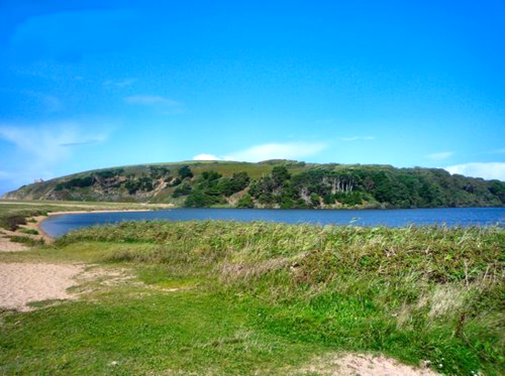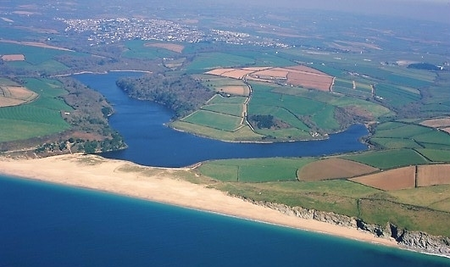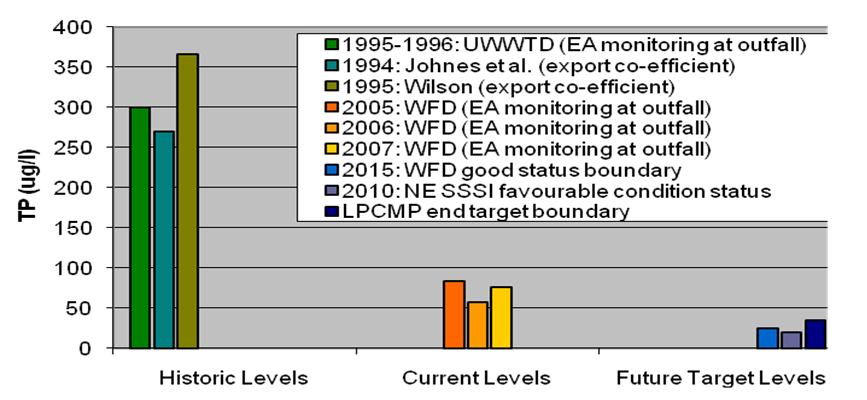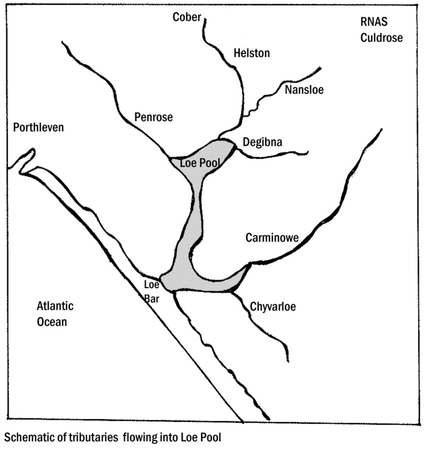Loe Pool Management Forum— An update
Dr VICTORIA HOLMES
Cornwall College,
Pool, Redruth,
Cornwall
ECG Bulletin January 2010
Cornwall College,
Pool, Redruth,
Cornwall
ECG Bulletin January 2010
Are the objectives set by the Loe Pool Management Forum (LPMF) being achieved? Leo Salter reported on the LPMF in the July 2003 issue of the ECG Bulletin. Victoria Holmes, from Cornwall College, provides an update on the progress to rehabilitate Loe Pool to an ecologically stable condition.
Loe Pool.
Loe Pool (Figure 1) is the largest natural freshwater lake in Cornwall with a surface area of 0.56 km2, and the main inflow, the River Cober, has a drainage area of 54 km2. This shallow coastal lake has considerable amenity value (30,000 visitors p.a. (National Trust, 1998)) and is of national significance, which is reflected by its designation as a Site of Special Scientific Interest and County Wildlife Site (Dinsdale, 2009).Nitrogen and phosphorus inputs.
Concentrations of nitrogen and phosphorus have been elevated in the Pool, possibly for decades, fuelling proliferation of algae (Microcystis aeruginosa and Hydrodictyon reticulatum) and therefore the demise of submerged macrophytes and the populations of coarse fish. The Pool suffers from advanced euthrophication, with predominant inputs of phosphorus sourced from the Helston Sewage Treatment Works (STW) and the STW located at the Royal Naval Air Station (RNAS), Culdrose, plus nitrogen inputs from diffuse sources (mainly agriculture).Review of the Loe Pool Catchment Management Project.
In 1998, project targets and objectives were defined by the Loe Pool Catchment Management Project (LPCMP) and these remain largely unchanged in 2009. Since the introduction of the Water Framework Directive, Loe Pool is subject to an extensive programme of long-term monitoring, which will allow the progress towards the Project’s targets to be assessed for the first time. The findings from the latest LPCMP review (Figure 2, Dinsdale, 2009) show a four-fold reduction in the average annual total phosphorus concentration of Loe Pool between 1997 and 2004. This reduction coincides with the installation of tertiary treatment (phosphorus stripping) at the Helston STW in 2003 (Urban Wastewater Treatment Directive) and work to tackle pollution from agriculture (1999 to 2009) (Dinsdale, 2009).The reduction in total phosphorus is extremely encouraging as it indicates there is currently little remobilisation of phosphorus from the benthic sediments in the Pool, which is in contrast with findings from other lake restoration schemes (Marsden, 1989; Phillips, 2005). Levels of phosphorus within the sediment could potentially have become a significant source of phosphorus during the lake rehabilitation (Wilson & Dinsdale, 1998). However, it was predicted that iron present in the sediment from historic mining activities in this area of Cornwall, would absorb the sedimentary phosphorus (Olosundé, 2002). The data appear to support this theory.
High peaks in the concentrations of total phosphorus were found in Nansloe Stream and Chyvarloe Stream, which flow into Loe Pool (see Figure 3 for locations) (BREY Services, (2009). These peaks could not be consistently correlated with incidences of high rainfall (McCaffrey, 2008), but are thought to be linked to agricultural activities. Phosphate levels are high and consistent in Carminowe Stream, where the primary source of phosphorus is likely to be RNAS Culdrose Sewage Treatment Works. The majority of phosphorus entering Loe Pool is in the biologically available form of orthophosphate (BREY Services, 2009). The largest proportional contribution to the total phosphorus in Loe Pool was from the River Cober (61%), despite this source having a relatively low phosphorus concentration. Carminowe Stream and Nansloe Stream also contribute phosphorus, and high nitrate and ammonia concentrations were found in a few of the tributary streams (McCaffery 2008; BREY Services, 2009).
High peaks in the concentrations of total phosphorus were found in Nansloe Stream and Chyvarloe Stream, which flow into Loe Pool (see Figure 3 for locations) (BREY Services, (2009). These peaks could not be consistently correlated with incidences of high rainfall (McCaffrey, 2008), but are thought to be linked to agricultural activities. Phosphate levels are high and consistent in Carminowe Stream, where the primary source of phosphorus is likely to be RNAS Culdrose Sewage Treatment Works. The majority of phosphorus entering Loe Pool is in the biologically available form of orthophosphate (BREY Services, 2009). The largest proportional contribution to the total phosphorus in Loe Pool was from the River Cober (61%), despite this source having a relatively low phosphorus concentration. Carminowe Stream and Nansloe Stream also contribute phosphorus, and high nitrate and ammonia concentrations were found in a few of the tributary streams (McCaffery 2008; BREY Services, 2009).

Work for the next quinquennium. The Loe Pool Catchment Management Project remains at the first step of a three-stage rehabilitation: (1) reduction of nutrient loading; (2) biomanipulation; (3) recovery of water plants. Management for the next five years needs to continue restricting the sources of phosphate and other nutrients within the catchment area (Dinsdale, 2009). One of the priorities for 2009-2014 will be the reduction in the export of phosphorus from sewage works at RNAS Culdrose, ideally through the installation of a phosphate removal plant. Currently, the Environment Agency is assessing the evidence to see if there is sufficient cause to modify the consent to discharge. Another priority is the reduction of agricultural sources of nutrients, sediments and pesticides. This goal will be achieved through the Rural Catchment Initiative. A ‘nutrient budget’ will also be established to account for the various nutrient sources of phosphorus within the catchment. Finally, two outcomes from the current LPCMP Review (Dinsdale, 2009) have been the rehabilitation of the River Cober following its reprofiling to reduce a flood risk at Helston, and the adaptation of a water regime to allow the re-establishment of submerged vegetation in Loe Pool.
References
BREY Services (2009). Unpublished water chemistry data set pertaining to the six watercourses flowing into Loe Pool, April 2007 to July 2008. BREY Services Ltd, Sheffield.
Dinsdale, J. (2009). Loe Pool Catchment Management Project, 2009 Review, Loe Pool Management Forum.
Marsden, M.W. (1989). Lake restoration by reducing external phosphorus loading: The influence of sediment phosphorus release. Freshwater Biology, 21, 139-62.
McCaffrey, L. (2008). Interim results of a Loe Pool tributary nutrient study. Presentation to Loe Pool Management Forum, September
2008. BREY Service Ltd, Sheffield.
National Trust (1998). Penrose and Mounts Bay Estates Management Plan: Report to National Trust, National Trust, Penrose.
Olosundé, J. (2002). Sediment Phosphorus in Loe Pool, Cornwall. Unpublished Post-Graduate Report, University of Leicester.
Phillips, G.L. (2005). Eutrophication of shallow temperature lakes. In The Lakes Handbook: Lake Restoration and Rehabilitation, Volume 2, O’Sullivan, P.E.; Reynolds, C.S. (eds.), Wiley-Blackwell, Oxford, 2004, pp. 261-278.
Salter, L. (2003) The Loe Pool Management Forum, RSC Environmental Chemistry Group Bulletin, July 2003, pp 14-15.
Wilson, H.; Dinsdale, J. (1998). Loe Pool Catchment Management Project, Final Report, Environment Agency, Bodmin.
Dr VICTORIA HOLMES
Cornwall College,
Pool, Redruth,
Cornwall
December 2009
References
BREY Services (2009). Unpublished water chemistry data set pertaining to the six watercourses flowing into Loe Pool, April 2007 to July 2008. BREY Services Ltd, Sheffield.
Dinsdale, J. (2009). Loe Pool Catchment Management Project, 2009 Review, Loe Pool Management Forum.
Marsden, M.W. (1989). Lake restoration by reducing external phosphorus loading: The influence of sediment phosphorus release. Freshwater Biology, 21, 139-62.
McCaffrey, L. (2008). Interim results of a Loe Pool tributary nutrient study. Presentation to Loe Pool Management Forum, September
2008. BREY Service Ltd, Sheffield.
National Trust (1998). Penrose and Mounts Bay Estates Management Plan: Report to National Trust, National Trust, Penrose.
Olosundé, J. (2002). Sediment Phosphorus in Loe Pool, Cornwall. Unpublished Post-Graduate Report, University of Leicester.
Phillips, G.L. (2005). Eutrophication of shallow temperature lakes. In The Lakes Handbook: Lake Restoration and Rehabilitation, Volume 2, O’Sullivan, P.E.; Reynolds, C.S. (eds.), Wiley-Blackwell, Oxford, 2004, pp. 261-278.
Salter, L. (2003) The Loe Pool Management Forum, RSC Environmental Chemistry Group Bulletin, July 2003, pp 14-15.
Wilson, H.; Dinsdale, J. (1998). Loe Pool Catchment Management Project, Final Report, Environment Agency, Bodmin.
Dr VICTORIA HOLMES
Cornwall College,
Pool, Redruth,
Cornwall
December 2009




